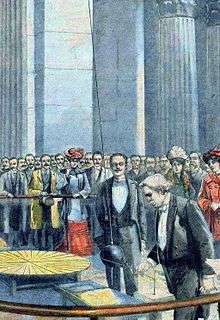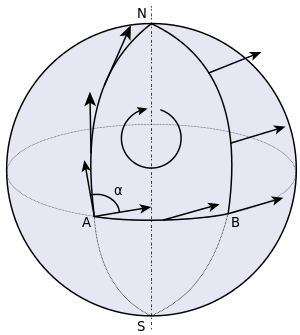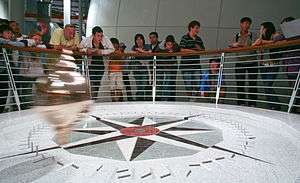Foucault pendulum

The Foucault pendulum (English pronunciation: /fuːˈkoʊ/ foo-KOH; French pronunciation: [fuˈko]), or Foucault's pendulum, named after the French physicist Léon Foucault, is a simple device conceived as an experiment to demonstrate the rotation of the Earth. While it had long been known that the Earth rotates, the introduction of the Foucault pendulum in 1851 was the first simple proof of the rotation in an easy-to-see experiment. Today, Foucault pendulums are popular displays in science museums and universities.[1]
Original Foucault pendulum
The first public exhibition of a Foucault pendulum took place in February 1851 in the Meridian of the Paris Observatory. A few weeks later, Foucault made his most famous pendulum when he suspended a 28-kg brass-coated lead bob with a 67-m-long wire from the dome of the Panthéon, Paris. The plane of the pendulum's swing rotated clockwise 11° per hour, making a full circle in 32.7 hours. The original bob used in 1851 at the Panthéon was moved in 1855 to the Conservatoire des Arts et Métiers in Paris. A second temporary installation was made for the 50th anniversary in 1902.[2]
During museum reconstruction in the 1990s, the original pendulum was temporarily displayed at the Panthéon (1995), but was later returned to the Musée des Arts et Métiers before it reopened in 2000.[3] On April 6, 2010, the cable suspending the bob in the Musée des Arts et Métiers snapped, causing irreparable damage to the pendulum and to the marble flooring of the museum.[4][5] An exact copy of the original pendulum had been swinging permanently since 1995 under the dome of the Panthéon, Paris until 2014 when it was taken down during repair work to the building. The pendulum has since been reinstalled.
Explanation of mechanics

At either the North Pole or South Pole, the plane of oscillation of a pendulum remains fixed relative to the distant masses of the universe while Earth rotates underneath it, taking one sidereal day to complete a rotation. So, relative to Earth, the plane of oscillation of a pendulum at the North Pole undergoes a full clockwise rotation during one day; a pendulum at the South Pole rotates counterclockwise.
When a Foucault pendulum is suspended at the equator, the plane of oscillation remains fixed relative to Earth. At other latitudes, the plane of oscillation precesses relative to Earth, but slower than at the pole; the angular speed, ω (measured in clockwise degrees per sidereal day), is proportional to the sine of the latitude, φ:
where latitudes north and south of the equator are defined as positive and negative, respectively. For example, a Foucault pendulum at 30° south latitude, viewed from above by an earthbound observer, rotates counterclockwise 360° in two days.
To demonstrate rotation directly rather than indirectly via the swinging pendulum, Foucault used a gyroscope in an 1852 experiment. The inner gimbal of Foucault gyroscope was balanced on knife edge bearings on the outer gimbal and the outer gimbal was suspended by a fine, torsion-free thread in such a manner that the lower pivot point carried almost no weight. The gyro was spun to 9000-12000 revolutions per minute with an arrangement of gears before being placed into position, which was sufficient time to balance the gyroscope and carry out 10 minutes of experimentation. The instrument could be observed either with a microscope viewing a tenth of a degree scale or by a long pointer. At least three more copies of a Foucault gyro were made in convenient travelling and demonstration boxes and copies survive in the UK, France, and the USA.
A Foucault pendulum requires care to set up because imprecise construction can cause additional veering which masks the terrestrial effect. The initial launch of the pendulum is critical; the traditional way to do this is to use a flame to burn through a thread which temporarily holds the bob in its starting position, thus avoiding unwanted sideways motion (see a detail of the launch at the 50th anniversary in 1902).

Air resistance damps the oscillation, so some Foucault pendulums in museums incorporate an electromagnetic or other drive to keep the bob swinging; others are restarted regularly, sometimes with a launching ceremony as an added attraction.

A 'pendulum day' is the time needed for the plane of a freely suspended Foucault pendulum to complete an apparent rotation about the local vertical. This is one sidereal day divided by the sine of the latitude.[7][8]
Precession as a form of parallel transport


From the perspective of an inertial frame moving in tandem with Earth, but not sharing its rotation, the suspension point of the pendulum traces out a circular path during one sidereal day. At the latitude of Paris, 48 degrees 51 minutes north, a full precession cycle takes just under 32 hours, so after one sidereal day, when the Earth is back in the same orientation as one sidereal day before, the oscillation plane has turned 270 degrees. If the plane of swing was north-south at the outset, it is east-west one sidereal day later. This implies that there has been exchange of momentum; the Earth and the pendulum bob have exchanged momentum. The Earth is so much more massive than the pendulum bob that the Earth's change of momentum is unnoticeable. Nonetheless, since the pendulum bob's plane of swing has shifted, the conservation laws imply that an exchange must have occurred.
Rather than tracking the change of momentum, the precession of the oscillation plane can efficiently be described as a case of parallel transport. For that, it can be demonstrated, by composing the infinitesimal rotations, that the precession rate is proportional to the projection of the angular velocity of Earth onto the normal direction to Earth, which implies that the trace of the plane of oscillation will undergo parallel transport. After 24 hours, the difference between initial and final orientations of the trace in the Earth frame is α = −2πsin(φ), which corresponds to the value given by the Gauss–Bonnet theorem. α is also called the holonomy or geometric phase of the pendulum. When analyzing earthbound motions, the Earth frame is not an inertial frame, but rotates about the local vertical at an effective rate of 2π sin(φ) radians per day. A simple method employing parallel transport within cones tangent to the Earth's surface can be used to describe the rotation angle of the swing plane of Foucault's pendulum.[9][10]
From the perspective of an Earth-bound coordinate system with its x-axis pointing east and its y-axis pointing north, the precession of the pendulum is described by the Coriolis force. Consider a planar pendulum with natural frequency ω in the small angle approximation. There are two forces acting on the pendulum bob: the restoring force provided by gravity and the wire, and the Coriolis force. The Coriolis force at latitude φ is horizontal in the small angle approximation and is given by
where Ω is the rotational frequency of Earth, Fc,x is the component of the Coriolis force in the x-direction and Fc,y is the component of the Coriolis force in the y-direction.
The restoring force, in the small-angle approximation, is given by
Using Newton's laws of motion this leads to the system of equations
Switching to complex coordinates z = x + iy, the equations read
To first order in Ω/ω this equation has the solution
If time is measured in days, then Ωt = 2π and the pendulum rotates by an angle of −2π sin(φ) during one day.
Related physical systems

Many physical systems precess in a similar manner to a Foucault pendulum. As early as 1836, the Scottish mathematician Edward Sang contrived and explained the precession of a spinning top. In 1851, Charles Wheatstone [11] described an apparatus that consists of a vibrating spring that is mounted on top of a disk so that it makes a fixed angle with the disk. The spring is struck so that it oscillates in a plane. When the disk is turned, the plane of oscillation changes just like the one of a Foucault pendulum at latitude .
Similarly, consider a nonspinning, perfectly balanced bicycle wheel mounted on a disk so that its axis of rotation makes an angle with the disk. When the disk undergoes a full clockwise revolution, the bicycle wheel will not return to its original position, but will have undergone a net rotation of .
Foucault-like precession is observed in a virtual system wherein a massless particle is constrained to remain on a rotating plane that is inclined with respect to the axis of rotation.[12]
Spin of a relativistic particle moving in a circular orbit precesses similar to the swing plane of Foucault pendulum. The relativistic velocity space in Minkowski spacetime can be treated as a sphere S3 in 4-dimensional Euclidean space with imaginary radius and imaginary timelike coordinate. Parallel transport of polarization vectors along such sphere gives rise to Thomas precession, which is analogous to the rotation of the swing plane of Foucault pendulum due to parallel transport along a sphere S2 in 3-dimensional Euclidean space.[13]
In physics, the evolution of such systems is determined by geometric phases.[14][15] Mathematically they are understood through parallel transport.
Foucault pendulums around the world

Numerous Foucault pendulums are installed around the world, mainly at universities, science museums, and planetariums. The United Nations headquarters in New York City has one, while the largest Foucault pendulum in the world, Principia, is housed at the Oregon Convention Center.[16][17]
South Pole
The experiment has also been carried out at the South Pole, where it was assumed that the rotation of the earth would have maximum effect. The South Pole Pendulum Project (as discussed in The New York Times[18] and excerpted from Seven Tales of the Pendulum[19]) was constructed and tested by adventurous experimenters John Bird, Jennifer McCallum, Michael Town, and Alan Baker at the Amundsen–Scott South Pole Station. Their measurement is probably the closest ever made to one of the earth's poles. The pendulum was erected in a six-story staircase of a new station that was under construction near the pole. Conditions were challenging; the altitude was about 3,300 m (atmospheric pressure only about 65% that at sea level) and the temperature in the unheated staircase was about −68 °C (−90 °F). The pendulum had a length of 33 m and the bob weighed 25 kg. The new station offered an ideal venue for the Foucault pendulum; its height ensured an accurate result, no moving air could disturb it, and low air pressure reduced air resistance. The researchers confirmed about 24 hours as the rotation period of the plane of oscillation.
See also
- Coriolis effect
- Earth's rotation
- Eötvös experiment
- Inertial frame
- Absolute rotation
- Lariat chain
- Precession
References
- ↑ Oprea, John (1995). "Geometry and the Foucault Pendulum". Amer. Math. Monthly. 102: 515–522. doi:10.2307/2974765.
- ↑ "The Pendulum of Foucault of the Panthéon. Ceremony of inauguration by M. Chaumié, minister of the state education, burnt the wire of balancing, to start the pendulum. 1902". Paris en images.
- ↑ Kissell, Joe (November 8, 2004). "Foucault's Pendulum: Low-tech proof of Earth's rotation". Interesting thing of the day. Retrieved March 21, 2012.
- ↑ Thiolay, Boris (April 28, 2010). "Le pendule de Foucault perd la boule" (in French). L'Express.
- ↑ "Foucault's pendulum is sent crashing to Earth". Times Higher Education. 13 May 2010. Retrieved March 21, 2012.
- ↑ "Foucault Pendulum". Smithsonian Encyclopedia. Retrieved September 2, 2013.
- ↑ "Pendulum day". Glossary of Meteorology. American Meteorological Society.
- ↑ Daliga, K.; Przyborski, M.; Szulwic, J. "Foucault's Pendulum. Uncomplicated Tool In The Study Of Geodesy And Cartography". library.iated.org. Retrieved 2015-11-02.
- ↑ W. B. Somerville, "The Description of Foucault's Pendulum", Q. J. R. Astron. Soc. 13, 40 (1972).
- ↑ J. B. Hart, R. E. Miller and R. L. Mills, "A simple geometric model for visualizing the motion of a Foucault pendulum", Am. J. Phys. 55, 67–70 (1987). doi:10.1119/1.14972
- ↑ Charles Wheatstone Wikisource: "Note relating to M. Foucault's new mechanical proof of the Rotation of the Earth", pp. 65–68.
- ↑ Bharadhwaj, Praveen (2014). "Foucault precession manifested in a simple system". arXiv:1408.3047
 [physics.pop-ph].
[physics.pop-ph]. - ↑ M. I. Krivoruchenko, "Rotation of the swing plane of Foucault's pendulum and Thomas spin precession: Two faces of one coin", Phys. Usp. 52, 821–829 (2009).
- ↑ "Geometric Phases in Physics", eds. Frank Wilczek and Alfred Shapere (World Scientific, Singapore, 1989).
- ↑ L. Mangiarotti, G. Sardanashvily, Gauge Mechanics (World Scientific, Singapore, 1998)
- ↑ http://www.andrewginzel.com/JONESGINZEL/PROJECTS/ALL/principia/principiatxt.html
- ↑ http://ltwautomation.net/casestudies.html#Pendulum
- ↑ Johnson, George (September 24, 2002). "Here They Are, Science's 10 Most Beautiful Experiments". The New York Times. Retrieved September 20, 2012.
- ↑ Baker, G. P. (2011). Seven Tales of the Pendulum. Oxford University Press. p. 388. ISBN 978-0-19-958951-7.
Further reading
- Persson, A. "The Coriolis Effect: Four centuries of conflict between common sense and mathematics, Part I: A history to 1885" History of Meteorology 2 (2005)
- Classical dynamics of particles and systems, 4ed, Marion Thornton ISBN 0-03-097302-3, pp. 398–401.
- V. I. Arnold, Mathematical Methods of Classical Mechanics, Springer-Verlag (1989), ISBN 0-387-96890-3, p. 123
External links
| Wikimedia Commons has media related to Foucault pendulum. |
- Julian Rubin, "The Invention of the Foucault Pendulum", Following the Path of Discovery, 2007, retrieved 2007-10-31. Directions for repeating Foucault's experiment, on amateur science site.
- Wolfe, Joe, "A derivation of the precession of the Foucault pendulum".
- "The Foucault Pendulum", derivation of the precession in polar coordinates.
- "The Foucault Pendulum" By Joe Wolfe, with film clip and animations.
- "Foucault's Pendulum" by Jens-Peer Kuska with Jeff Bryant, Wolfram Demonstrations Project: a computer model of the pendulum allowing manipulation of pendulum frequency, Earth rotation frequency, latitude, and time.
- "Webcam Kirchhoff-Institut für Physik, Universität Heidelberg".
- California academy of sciences, CA Foucault pendulum explanation, in friendly format
- Foucault pendulum model Exposition including a tabletop device that shows the Foucault effect in seconds.
- Foucault, M. L., Physical demonstration of the rotation of the Earth by means of the pendulum, Franklin Institute, 2000, retrieved 2007-10-31. Translation of his paper on Foucault pendulum.
- Tobin, William "The Life and Science of Léon Foucault".
- Bowley, Roger (2010). "Foucault's Pendulum". Sixty Symbols. Brady Haran for University of Nottingham.
- Foucault-inga Párizsban Foucault's Pendulum in Paris – video of the operating Foucault's Pendulum in the Panthéon (Hungarian).
- Pendolo nel Salone The Foucault Pendulum inside Palazzo della Ragione in Padova, Italy
- Daliga, K., Przyborski, M., & Szulwic, J. Foucault's Pendulum. Uncomplicated Tool in the Study of Geodesy and Cartography, EDULEARN15 Proceedings - 7th International Conference on Education and New Learning Technologies, Barcelona, Spain, ISBN 978-84-606-8243-1, 2015